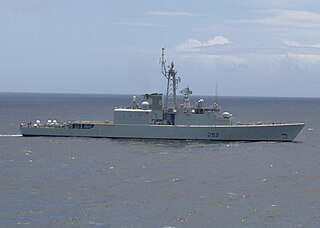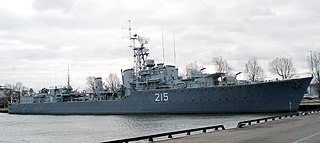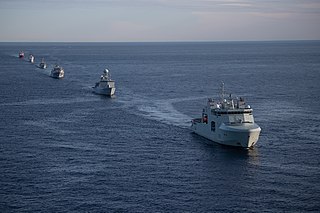The history of the Royal Canadian Navy goes back to 1910, when the naval force was created as the Naval Service of Canada and renamed a year later by King George V. The Royal Canadian Navy (RCN) is one of the three environmental commands of the Canadian Forces. Over the course of its history, the RCN has played a role in the First World War, contributed significantly to the Battle of the Atlantic during the Second World War, and was a part of NATO's force buildup during the Cold War. In 1968, the RCN was amalgamated with the Canadian Army and the Royal Canadian Air Force to form what is today the unified Canadian Armed Forces. The naval force was known as Maritime Command until 2011, when the environmental command was renamed as the Royal Canadian Navy.

Iroquois-class destroyers were a class of four helicopter-carrying, guided missile destroyers of the Royal Canadian Navy. The ships were named to honour the First Nations of Canada.

HMCS Athabaskan was an Iroquois-class destroyer that served in the Royal Canadian Navy from 1972 until 2017. Athabaskan was the third ship of her class which is sometimes referred to as the Tribal class or simply as the 280 class. She is the third vessel to use the designation HMCS Athabaskan.

The Tribal class, or Afridi class, was a class of destroyers built for the Royal Navy, Royal Canadian Navy and Royal Australian Navy that saw service in World War II. Originally conceived during design studies for a light fleet cruiser, the Tribals evolved into fast, powerful destroyers, with greater emphasis on guns over torpedoes than previous destroyers, in response to new designs by Japan, Italy, and Germany. The Tribals were well admired by their crews and the public when they were in service due to their power, often becoming symbols of prestige while in service.

HMCS Halifax is a Halifax-class frigate that has served in the Royal Canadian Navy and Canadian Forces since 1992. Halifax is the lead ship in her class which is the name for the Canadian Patrol Frigate Project. She is the second vessel to carry the designation HMCS Halifax. She carries the hull classification symbol FFH 330.

HMCS Goose Bay is a Kingston-class coastal defence vessel that has served in the Canadian Forces since 1998. Goose Bay is the eighth ship of her class which is the name for the Maritime Coastal Defence Vessel Project. She is the first vessel to be named Goose Bay. The coastal defence vessel is assigned to Maritime Forces Atlantic (MARLANT) and is homeported at CFB Halifax.

HMCS Montréal is a Halifax-class frigate that has served in the Canadian Forces since 1993. Montréal is the seventh ship in her class which is based on the Canadian Patrol Frigate Project. She is the second vessel to carry the designation HMCS Montreal. She is assigned to Maritime Forces Atlantic (MARLANT) and is homeported at CFB Halifax. Montréal serves on MARLANT missions protecting Canada's sovereignty in the Atlantic and Arctic Oceans and enforcing Canadian laws in its territorial sea and Exclusive Economic Zone. The ship has also been deployed on missions throughout the Atlantic and to the Indian Ocean; specifically the Persian Gulf and Arabian Sea on anti-terrorism operations. The vessel has also participated in several NATO missions, patrolling the Atlantic Ocean as part of Standing Naval Force Atlantic (STANAVFORLANT) and its successor Standing NATO Response Force Maritime Group 1 (SNMG1). The vessel is designated as a Bilingual Language Unit in the Royal Canadian Navy.

HMCS Fredericton is a Halifax-class frigate that has served in the Canadian Forces since 1994. Fredericton is the eighth ship in her class which is based on the Canadian Patrol Frigate Project. She is the second vessel to carry the name. Fredericton serves on MARLANT missions protecting Canada's sovereignty in the Atlantic Ocean and enforcing Canadian laws in its territorial sea and Exclusive Economic Zone. Fredericton has also been deployed on missions throughout the Atlantic and to the Indian Ocean; specifically the Persian Gulf and Arabian Sea on anti-terrorism operations. Fredericton has also participated in several NATO missions, patrolling the Atlantic Ocean as part of Standing Naval Force Atlantic (STANAVFORLANT) and its successor Standing NATO Response Force Maritime Group 1 (SNMG1). The frigate is assigned to Maritime Forces Atlantic (MARLANT) and is homeported at CFB Halifax.

HMCS St. John's is a Halifax-class frigate that has served in the Canadian Forces and the Royal Canadian Navy since her commissioning in 1996. She is the eleventh of twelve ships in her class which is based on the Canadian Patrol Frigate Project. St. John's is named after the city of St. John's, Newfoundland and Labrador, a port city associated with Canadian naval history and heritage, and is the first ship in the Royal Canadian Navy to bear the name.

HMCS Huron was an Iroquois-class destroyer that served with the Canadian Forces from 16 December 1972 to 23 October 2000. She served mainly on the western coast of Canada. After decommissioning, her hull was stripped to be used in a live-fire exercise. The ship's hulk was eventually sunk by gunfire from her sister ship, HMCS Algonquin. Huron was the second ship of her class and the second vessel to use the designation HMCS Huron.

HMCS Edmonton is a Kingston-class coastal defence vessel that has served in the Canadian Forces since 1997. Edmonton is the fourth ship of its class, all of which were built for the Maritime Coastal Defence Vessel Project. The ship is the first vessel to use the designation HMCS Edmonton. The ship is assigned to Maritime Forces Pacific (MARPAC) and is homeported at CFB Esquimalt.

HMCS Moncton is a Kingston-class coastal defence vessel that has served in the Canadian Forces since 1998. Moncton is the ninth ship of her class. She is the second vessel to use the designation HMCS Moncton. The ship is assigned to Maritime Forces Atlantic (MARLANT) and is homeported at CFB Halifax.

HMCS Saskatoon is a Kingston-class coastal defence vessel delivered to the Canadian Forces in 1998. Saskatoon is the tenth ship of her class and is the second vessel to use the designation HMCS Saskatoon. Named after the Canadian city of Saskatoon, Saskatchewan, other references to the city are found on the ship with the ships captains desk named Cranberry Flats and a main corridor in the ship named after Idylwyld Drive. Saskatoon is assigned to Maritime Forces Pacific (MARPAC) of the Royal Canadian Navy and is homeported at Canadian Forces Base (CFB) Esquimalt.

HMCS Summerside is a Kingston-class coastal defence vessel of the Royal Canadian Navy that has served in the Canadian Forces since 1999. Summerside is the twelfth, and last, ship of her class. She is the second vessel to use the designation HMCS Summerside. She is assigned to Maritime Forces Atlantic (MARLANT) and is homeported at CFB Halifax.

HMCS Protecteur was the lead ship of the Protecteur-class replenishment oilers in service with the Royal Canadian Navy. She was part of Maritime Forces Pacific (MARPAC), homeported at CFB Esquimalt, British Columbia. Built by Saint John Shipbuilding and Dry Docks in Saint John, New Brunswick, she was commissioned on 30 August 1969. She was the first Canadian naval unit to carry the name Protecteur; however, there have been several units, including a base, named HMCS Protector.

Operation Friction was a Canadian military operation that saw the contribution of 4,500 Canadian Forces personnel to the 1991 Gulf War. The larger US components were Operation Desert Shield and Operation Desert Storm.

Operation Nanook is an annual sovereignty operation and manoeuvre warfare exercise conducted by the Canadian Armed Forces in the Arctic. Sovereignty patrols in the Canadian Arctic Archipelago and northern Canada are conducted by the Canadian Rangers, Canadian Coast Guard in tandem with the Royal Canadian Mounted Police. The exercise portion is intended to train the different elements of the Canadian Armed Forces to operate in the Arctic environment, as well as promote cooperation with allies and close military partners such as the United States Navy and Royal Danish Navy. It can involve multiple components, which are conducted at different times, places and by different units.

Operation Hestia is the name of the Canadian Forces humanitarian response to the 2010 Haiti earthquake which struck Haiti on 12 January 2010. Operation Hestia is the military component of an interagency response that also involves Foreign Affairs and International Trade Canada (DFAIT) and the Canadian International Development Agency (CIDA). The headquarters for Operation Hestia were established in the city of Jacmel.
Operation Caribbe is the Canadian Armed Forces contribution to the elimination of illegal trafficking in the Caribbean Sea and the eastern Pacific Ocean by organized crime. The operation began in 2006 and its mandate has been altered twice since then. It operates as part of Operation Martillo.

Scott Edward George Bishop is a Canadian naval flag officer serving as a Vice Admiral in the Royal Canadian Navy. He presently serves as Canada's Military Representative to the NATO Military Committee, and was commander of the Canadian Forces Intelligence Command from 2016 to 2021.

















